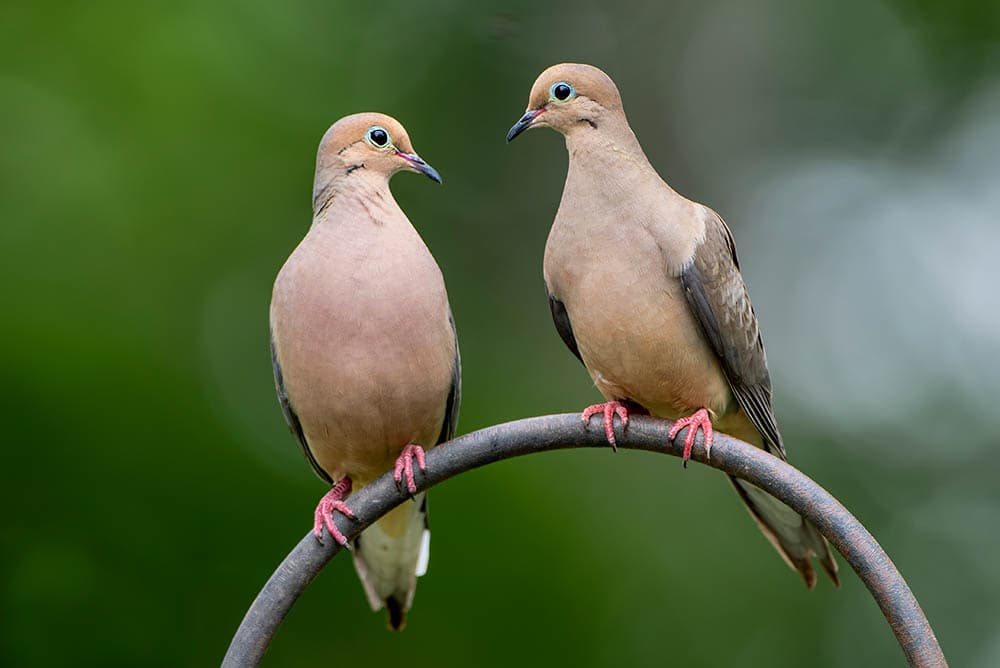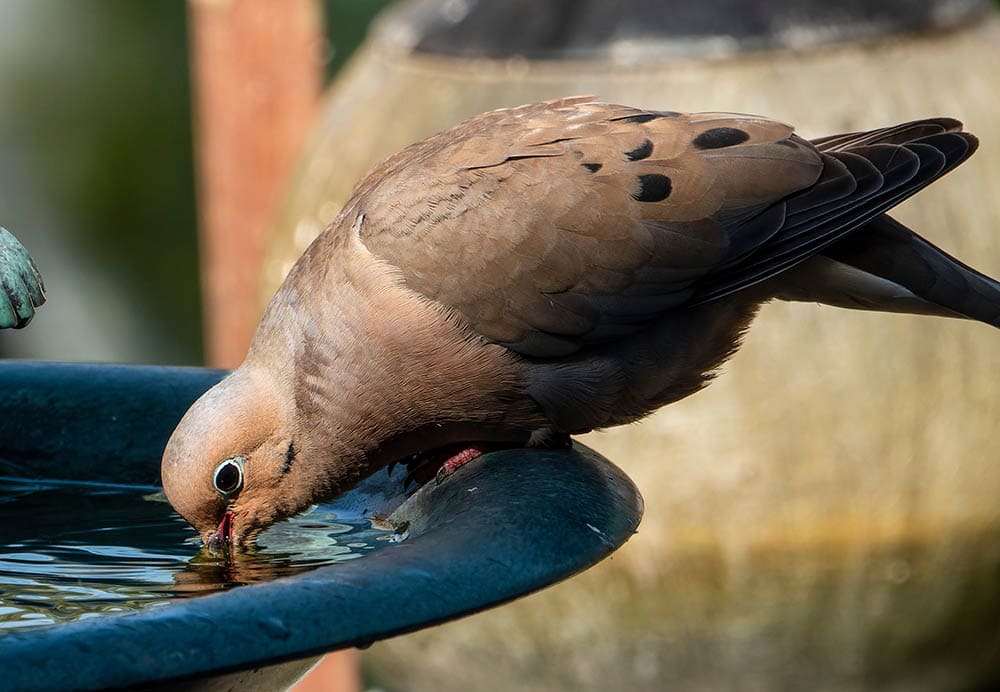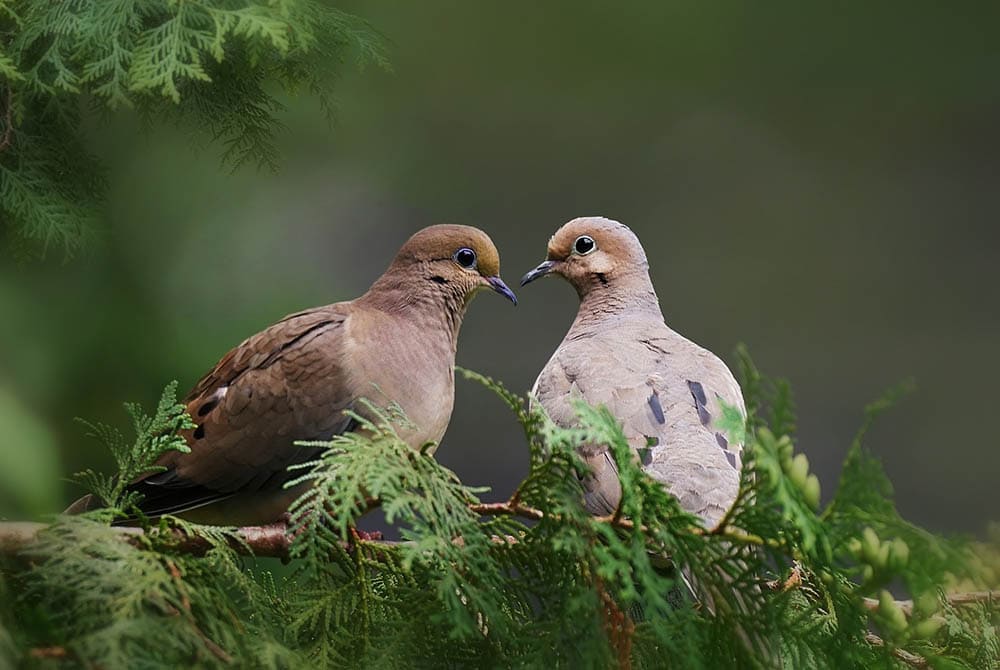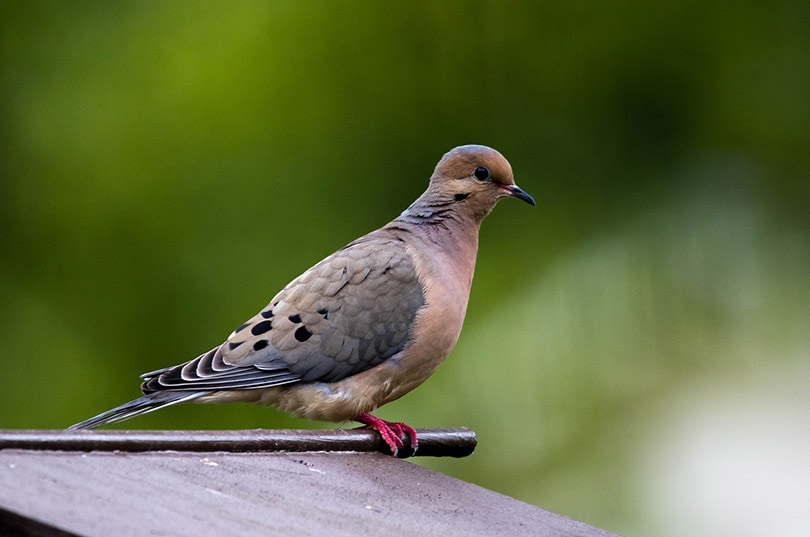16 Interesting & Fun Mourning Dove Facts
Last Updated on

The Mourning Dove (Zenaida Macroura) is a member of the dove family and can be found in the United States, Canada, Mexico, Bermuda, Cuba, Jamaica, and Puerto Rico. Although estimates vary, there are several hundred million of the species, including more than 100 million in mainland US, making it one of the most populous birds in the country, which is why it remains one of the most popularly hunted bird games.

16 Facts About Mourning Doves
Named for its call, the Mourning Dove has a call that can sound like that of an owl and is sometimes mistaken for the Collared Dove, although there are differences between the two. Read on for 16 facts about Mourning Doves.
Diet
1. They Eat Weed Seeds
The vast majority of a Mourning Dove’s diet is seeds. More specifically, they eat weed seeds, which means that they should be popular with gardeners. However, they do also eat corn, which lessens their popularity with farmers and homesteaders. They prefer to forage food from the floor and can eat as much as 20% of their own body weight each day. (Birds&Blooms)

2. They Stockpile Seeds to Eat Later
While they do eat a lot of seeds each day, not every seed they collect from the floor is consumed straight away. They have a crop, which is a part of the esophagus or throat, where they can store seeds. So, if you see one picking up what seems like an extraordinary amount of seeds, they could be storing them for later. One Mourning Dove was found with more than 17,000 bluegrass seeds in its crop. (Birds&Blooms)
3. Mourning Doves Eat as Much as 20% of Their Bodyweight Daily
Growing to more than 12 inches in length and typically weighing around 4.5 ounces, the Mourning Dove is a large backyard visitor, and it needs to eat a lot of seeds. Although they will live on seeds and grains, the species will also eat snails and insects, and they consume small stones which remain in the stomach and grind up other food to aid in digestion. (Facts.net)
4. Mourning Doves Can Survive in the Desert
Despite once having the name of the Rain Dove, this species has adapted to live in a wide variety of locales. Impressively, they can survive in the desert because they are able to drink brackish water. Brackish water has around half the salt content of seawater. It would dehydrate humans and a lot of other animal species, but not the Mourning Dove. (AllAboutBirds)
5. They Are One of Few Birds That Can Suck Up Water to Drink
Although typical among doves, the Mourning Dove is unusual among other birds because it has the ability to suck up water when drinking. Other birds fill their bills with water and then tip their heads at an angle to allow the water to run down their throat. The Mourning Dove can get its daily water requirements in less than 20 minutes. (WBU)

Characteristics
6. They Are Named for Their Mournful Call
Although they do have several other names and have had other names in the past, the Mourning Dove gets its name from its mournful, sad cooing sound. To the untrained ear, it can sound similar to the call of some owls, and many people find it relaxing to listen to, especially first thing in the morning. It is typically the male that is heard making the cooing sound, and it is meant to attract and woo a mate. (WBU)
7. Mourning Doves Can Fly at Speeds Over 50 Miles Per Hour
The species has long, pointed wings, similar to those of a falcon. They also have long, pointed tales. These aerodynamic features enable the Mourning Dove to regularly fly at speeds of 40 miles per hour, with some being clocked at hefty speeds of 55 miles per hour. This makes them one of the fastest backyard birds in the country. The Mourning Dove is also one of the fastest at erecting a nest—something they can do in a few hours compared to the several days required by most species. (Birds&Blooms)

8. They Can Live to 30 Years Old
The typical lifespan of the species is 1–2 years old, but the oldest living wild Mourning Dove was recorded to be 31 years old. This is the oldest recorded age of a North American land bird. Its age was recorded through banding and monitoring. (WBU)
9. It Goes by Many Names
Although most people know of this bird as the Mourning Dove, it is also referred to as the American Mourning Dove, Rain Dove, Turtle Dove, and Western Turtle Dove. It has also been called the Carolina Dove and the Carolina Pigeon. (A-Z Animals)
10. They Can Change Color According to Moisture Levels
It has been determined that the species changes the color of its feathers according to the moisture level in the air. The color changes on a molecular level, and it enables the bird to adjust its brightness to attract or repel moisture as needed. (Facts.net)
Mating and Reproduction
11. They Mate for Life… Sometimes
Although they are said to mate for life, recoupling with the same mate season after season, this isn’t always the case. Some birds will find a new mate, and if one of the birds dies, the other will go out and find a new mate. (Kidadl)

12. Mourning Doves Almost Always Lay Two Eggs
Mourning Doves almost always lay two eggs per clutch. Occasionally, they may lay one egg or more than two, but this is very rare. While other birds may lay more eggs per clutch, the Mourning Dove can have as many as six broods in a year, which is more than most others. This is one of the reasons that the species has become prevalent. (Wikipedia)
13. Male and Female Mourning Doves Co-Parent Babies
Mourning Doves co-parent their young. The male and female will work to build a nest, which can be completed in under a day, and both the male and female feed their babies on crop milk, which is essentially regurgitated food and is high in protein and fat. This doesn’t last long, however, as fledglings will start to eat seed after a few days, and it can take as little as 2 weeks for the young to fully fledge. (Birds&Blooms)
Population And Popularity
14. 70 Million Are Hunted Every Year in the US
The Mourning Dove remains one of the most popular game birds in the US with an estimated 70 million shot every year. While that number sounds huge, hunting is a long way down the list of the most common causes of death for the Mourning Dove. Inclement weather, predation, and disease account for five times more deaths per year than hunting. (WBU)

15. There May Be as Many as 400 Million Mourning Doves
Although 70 million are shot every year, the species’ large number of broods per year mean that the Mourning Dove remains one of the most populous birds in the country. Estimates vary, but it seems likely that there are more than 400 million in the contiguous United States during the fall months. This is when many of the birds from southern Canada migrate to the US and inflate the numbers. (WBU)
16. No States Have the Mourning Dove as Their State Bird
Although the Mourning Dove is adaptable and can be found in most states throughout the year, it has not been adopted as the official state bird in any of the country’s states. It is, however, listed as Wisconsin’s state bird symbol of peace. (Wikipedia 2)

Conclusion
Mourning Doves are among the most populous species of birds in the US and are also found in a number of neighboring countries and territories. They are quite remarkable birds, especially for the number of young they breed in a year, the incredible speeds that they can reach, and also for the beautiful, albeit sad and mournful, cooing call that they make. While corn growers might want to deter them, they can be a welcome addition to a backyard feeder where they will take a particular liking to corn, sunflower seeds, and other seeds.
Featured Image Credit: Bonnie Taylor Barry, Shutterstock
About the Author Robert Sparks
Robert’s obsession with all things optical started early in life, when his optician father would bring home prototypes for Robert to play with. Nowadays, Robert is dedicated to helping others find the right optics for their needs. His hobbies include astronomy, astrophysics, and model building. Originally from Newark, NJ, he resides in Santa Fe, New Mexico, where the nighttime skies are filled with glittering stars.
Related Articles:
10 Types of Hummingbirds in Arkansas (With Pictures)
8 Types of Hummingbirds in Nebraska (With Pictures)
5 Types of Hummingbirds in Idaho (With Pictures)
3 Types of Hummingbirds in Mississippi (With Pictures)
8 Types of Hummingbirds in Kansas (With Pictures)
5 Types of Hummingbirds in West Virginia (With Pictures)
5 Types of Hummingbirds in Ohio (With Pictures)
Where Do Nuthatches Nest? Nuthatch Nesting Habits Explained
